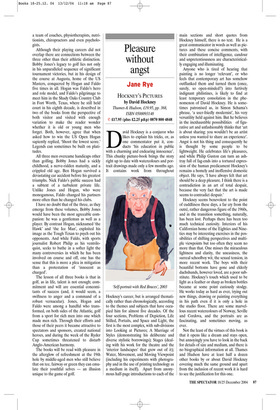Pleasure without angst
Jane Rye
HOCKNEY’S PICTURES by David Hockney Thames & Hudson, £19.95, pp. 368, ISBN 0500093148 ✆ £17.95 (plus £2.25 p&p) 0870 800 4848 David Hockney is a conjuror who likes to explain his tricks, or, as one commentator put it, conducts ‘his education in public with a charming and endearing innocence’. This chunky picture-book brings the story right up to date with watercolours and portrait drawings made only a few months ago. It contains work from throughout Hockney’s career, but is arranged thematically rather than chronologically, according to the themes and subjects that have occupied him for almost five decades. Of the four sections, Problems of Depiction, Life Stilled, Portaits, and Space and Light, the first is the most complex, with sub-divisions into Looking at Pictures; A Marriage of Styles (demonstrating his deliberate and diverse stylistic borrowings); Stages (dealing with his work for the theatre and the ‘interior landscapes’ that grew out of it); Water, Movement, and Moving Viewpoint (including his experiments with photography and in the use of printing technology as a medium in itself). Apart from anonymous half-page introductions to each of the main sections and short quotes from Hockney himself, there is no text. He is a great communicator in words as well as pictures and these concise comments, with their combination of intelligence, candour and unpretentiousness are characteristically engaging and illuminating.
Anyone who is tired of hearing that painting is no longer ‘relevant’, or who feels that contemporary art has somehow outflanked them and turned them (once, surely, so open-minded?) into furtively indignant philistines, is likely to find at least temporary consolation in the phenomenon of David Hockney. He is sometimes patronised as, in Simon Schama’s phrase, ‘a user-friedly modernist’, his very versatility held against him. But he believes in the inexhaustible posssibilities of figurative art and unfashionably thinks that ‘art is about sharing: you wouldn’t be an artist unless you wanted to share an experience’. Angst is not his thing and consequently he is thought by some people to be lightweight. He celebrates life’s pleasures, and while Philip Guston can turn an ashtray full of fag-ends into a tortured expression of the human predicament Hockney’s remains a homely and inoffensive domestic object. He says, ‘I have always felt that art should be a deep pleasure. I think there is a contradiction in an art of total despair, because the very fact that the art is made seems to contradict despair.’ Hockney seems benevolent to the point of cuddliness these days, a far cry from the outré, rather dangerous figure of the 1960s, and in the transition something, naturally, has been lost. Perhaps there has been too much technical curiosity. Interiors of his Californian home of the Eighties and Nineties may be interesting exercises in the possibilities of shifting perspectives and multiple viewpoints but too often they seem no more than that. One misses the miraculous lightness and clarity, the uneasiness, the surreal schoolboy wit, the sexual tension, in more recent work. The boys with their beautiful bottoms have gone and elderly dachshunds, however loved, are a poor substitute. Hockney’s touch which used to be light as a feather or sharp as broken bottles became at some point curiously stodgy. He works today as hard as ever, trying out new things, drawing or painting everything in his path even if it is only a hole in the studio floor. There are some marvellous recent watercolours of Norway, Seville and Cordova, and the portraits are as fascinating, and sometimes moving, as ever.
Not the least of the virtues of this book is that it opens like a dream and stays open, but annoyingly you have to look in the back for details of size and medium, and there is no biographical information at all. Thames and Hudson have at least half a dozen other books by or about David Hockney covering much the same ground and apart from the inclusion of recent work it is hard to see the justification for this one.

















































































 Previous page
Previous page